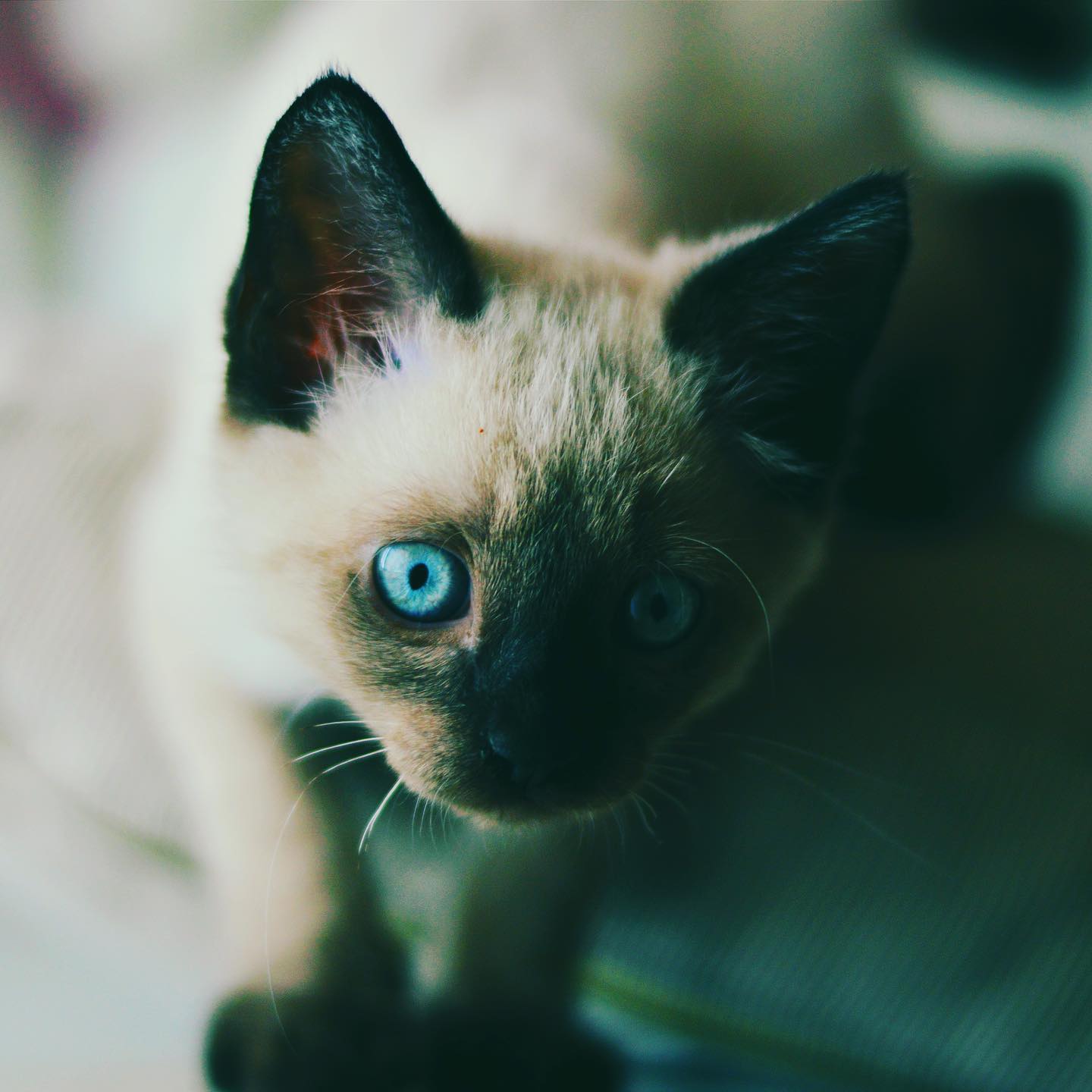Does Kibble Cause UTI in Cats As a devoted cat parent, I remember the night my tabby faced her first urinary tract infection (UTI). The restless meows, frequent litter box visits, and visible discomfort sparked my deep dive into understanding urinary tract infections in cats.
Urinary problems in cats are complex, with diet playing a critical role. When exploring whether kibble causes UTIs in cats, veterinary research reveals multiple interconnected factors. Cat health and nutrition are not simply about filling a food bowl.
Dry food diets present unique challenges. Studies indicate cats on kibble have a 20-25% higher prevalence of urine crystals. This statistic alone underscores the importance of understanding how your cat’s diet might impact their urinary tract health.
Your cat’s nutrition is more than a feeding routine—it’s a critical preventive healthcare strategy. By understanding the potential links between kibble and urinary tract infections, you can make informed choices that support your feline friend’s long-term wellness.
In this comprehensive guide, we’ll explore the intricate relationship between cat nutrition, kibble composition, and urinary tract health. Our goal is to empower you with knowledge that could potentially prevent future health complications.
Table of Contents
Introduction to Cat UTIs
Understanding urinary tract infections in cats is key to keeping them healthy. These infections can really affect your cat’s life and need your attention.
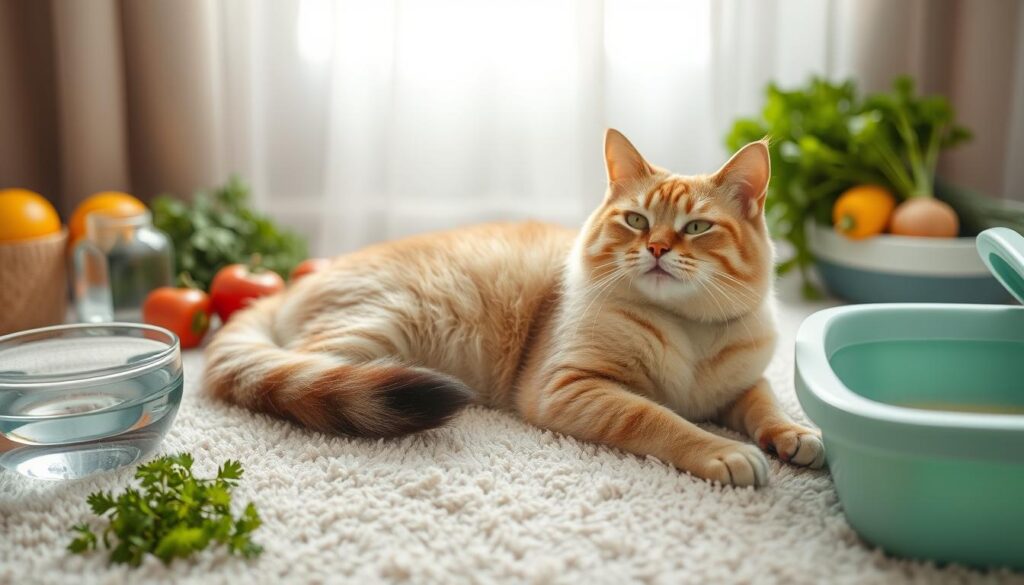
What is a Urinary Tract Infection?
A urinary tract infection (UTI) in cats is a bacterial infection in the bladder and urinary system. About 10% of cats will get some urinary tract problem in their life. These infections can be painful and serious if not treated.
Common Symptoms of Feline UTIs
It’s important to know the signs of urinary health issues in cats. Look out for these key signs:
- Frequent attempts to urinate
- Straining or pain during urination
- Blood in the urine
- Urinating outside the litter box
- Excessive licking of genital area
Studies show that about 30% of cats with urinary issues have pain when they pee. Feline UTI prevention starts with understanding these warning signs.
Risk Factors and Prevalence
| Age Group | UTI Risk |
|---|---|
| Kittens | Low |
| Adult Cats | Moderate |
| Senior Cats (10+ years) | High (up to 50% incidence) |
“Early detection and prompt veterinary care are key to managing feline urinary tract infections effectively.” – Veterinary Health Experts
Cat owners need to watch their pet’s urinary health closely. While UTIs are rare, they can lead to bigger problems if ignored.
The Role of Diet in Cat Health
Your cat’s diet is key to their health and avoiding urinary problems. Knowing about cat nutrition helps you pick the right food for them.
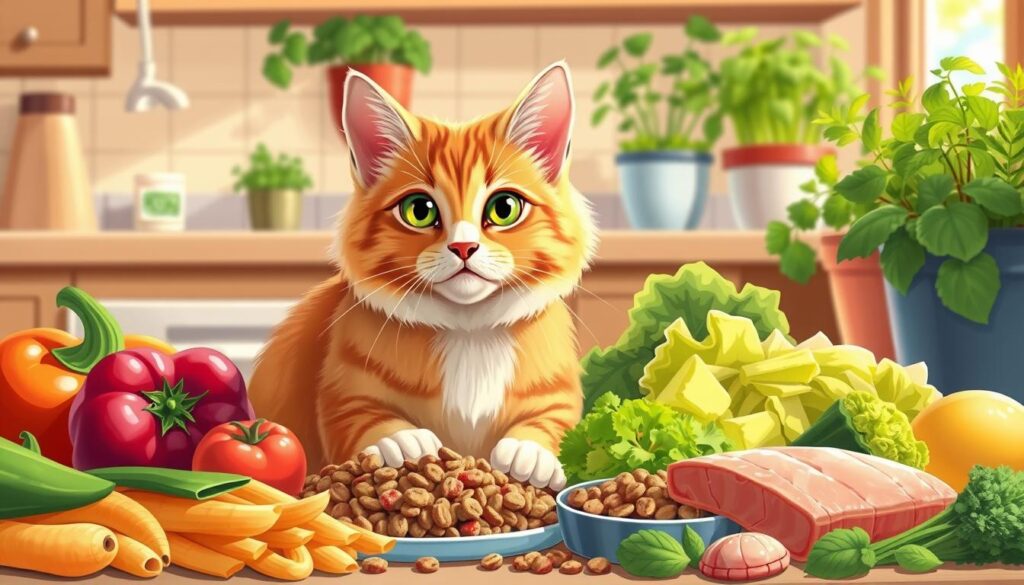
Good nutrition is vital for your cat’s health. Cats need specific foods because they are meat-eaters. The right diet gives them the nutrients they need.
Key Nutritional Considerations for Cats
- Protein is the most critical nutrient for cats
- Moisture content impacts urinary health
- Mineral balance affects urinary tract function
Wet Food vs. Dry Food: A Nutritional Comparison
Wet food for cats has many benefits. Dry food has less than 10% moisture, which can affect your cat’s water intake.
| Food Type | Moisture Content | Protein Level |
|---|---|---|
| Dry Kibble | < 10% | 25-32% |
| Wet Food | 78-83% | 10-12% |
“Hydration is key to maintaining your cat’s urinary tract health.” – Veterinary Nutrition Experts
Wet food’s moisture helps your cat’s urinary health. It prevents crystals and supports kidney function. Some vets suggest wet food for better hydration.
Mineral Management in Cat Nutrition
Minerals must be managed to avoid urinary problems. Too much calcium, phosphorus, and magnesium can cause stones.
Choosing the right diet means balancing protein, moisture, and minerals. Talk to your vet to find the best food for your cat.
Exploring Kibble: What is It?
Kibble is a common dry cat food that’s important for cat health. Knowing what’s in it helps you choose the right food for your cat.
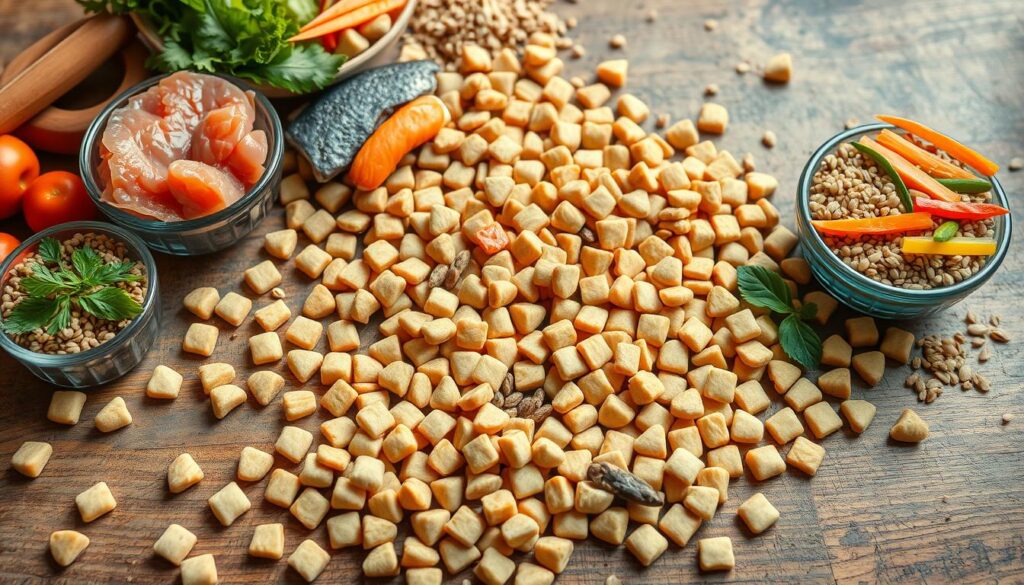
Dry cat food comes in many types, each for different needs. It’s key to pick kibble that’s good for your cat’s health.
Ingredients Commonly Found in Kibble
Kibble has a mix of ingredients for complete nutrition. The main parts are:
- Meat or fish meal (primary protein source)
- Grains or grain-free alternatives
- Added vitamins and minerals
- Preservatives
Types of Kibble Available
There are many kibbles for different health needs:
| Kibble Type | Primary Purpose | Key Characteristics |
|---|---|---|
| Weight Management | Control Cat’s Weight | Low-calorie, high-fiber |
| Urinary Health | Support Urinary Function | Low magnesium, balanced minerals |
| Senior Cat Formula | Age-Specific Nutrition | Reduced calories, joint support |
“Understanding kibble composition is crucial for maintaining your cat’s overall health and preventing potential urinary tract issues.” – Veterinary Nutritionist
About 30% of cat owners feed their pets kibble only. This might raise the risk of urinary problems. Picking the right kibble is important for your cat’s health.
Understanding Feline Anatomy
Your cat’s urinary system is complex and vital for their health. Knowing about feline anatomy helps you spot problems early. This knowledge supports your cat’s overall well-being.
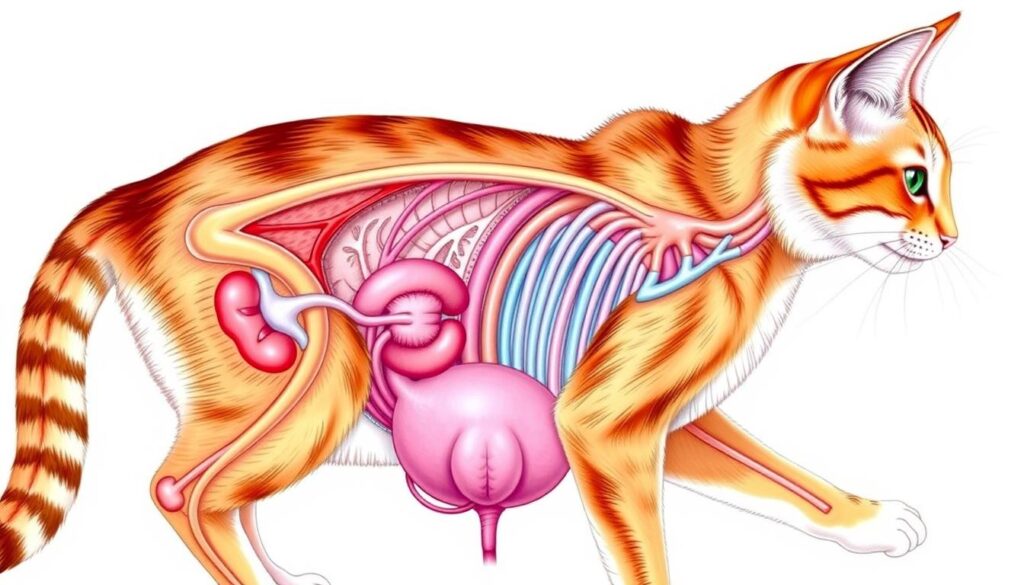
The feline urinary tract is designed to filter waste and keep your cat hydrated. Cats have unique features that make their urinary health extra sensitive.
Urinary Tract Structure in Cats
A cat’s urinary system has several key parts. These parts work together to remove waste and keep fluid balance. The main components are:
- Kidneys: Primary filtration organs
- Ureters: Tubes connecting kidneys to the bladder
- Bladder: Storage reservoir for urine
- Urethra: Passage for urine to exit the body
How Urinary Tracts Function
Feline urinary issues often come from anatomical differences. Male cats have narrower urethras, making them more prone to blockages.
“Understanding your cat’s unique anatomy is the first step in preventing potential urinary health complications.” – Veterinary Nutrition Experts
| Anatomical Feature | Male Cats | Female Cats |
|---|---|---|
| Urethra Width | Narrower | Wider |
| Blockage Risk | Higher | Lower |
| Urinary Tract Infection Susceptibility | More Prone | Less Susceptible |
Keeping your cat healthy and well-nourished is key for their urinary system. Regular vet visits and knowing about their anatomy can prevent urinary problems.
Can Kibble Contribute to UTIs?
It’s important for pet owners to know how kibble affects cat urinary health. Cats have special dietary needs. Their diet can greatly impact their health, especially when it comes to urinary tract infections (UTIs).
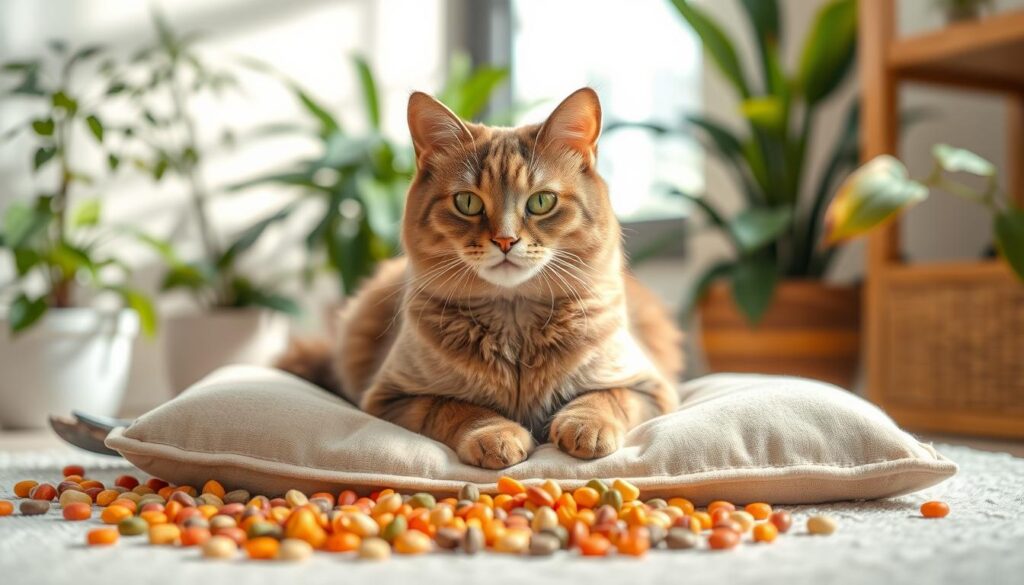
Veterinary studies show that dry cat food can be more than just food. The low moisture in kibble might lead to urinary health problems in cats.
Diet and Bladder Health: A Critical Connection
When looking into whether kibble causes UTIs in cats, several important points come up:
- Dry food usually has less than 10% moisture
- Low moisture can cause urine to be more concentrated
- Concentrated urine can lead to more mineral buildup
Research Insights into Urinary Tract Risks
“Hydration is the key to preventing urinary tract issues in cats.” – Veterinary Nutrition Experts
Research gives us important information about cat urinary health:
| Statistic | Relevance to UTI Risk |
|---|---|
| 30% of cats experience urinary tract disease | High lifetime risk |
| Cats need 4 oz water per 5 lbs body weight | Critical hydration benchmark |
| 70% improved urinary health after switching to wet food | Diet’s significant impact |
Your cat’s diet is very important for their urinary tract health. Knowing these risks can help you make better food choices for your cat.
The Moisture Factor
Hydration is key for your cat’s health, especially to prevent urinary tract infections (UTIs). Cats, being desert-dwelling predators, have a special relationship with water.
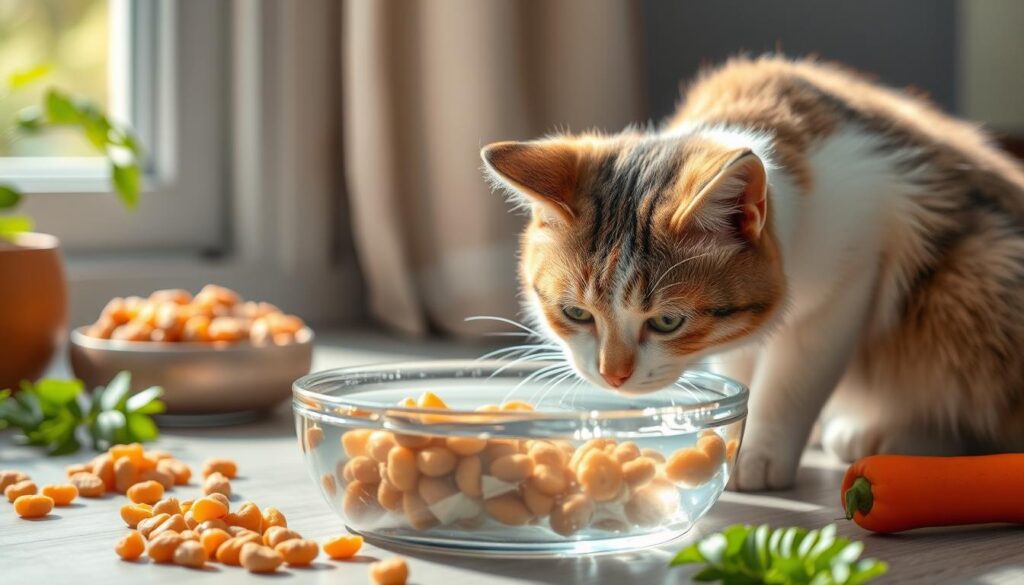
Dry cat food has less than 10% moisture. This can affect your cat’s hydration and urinary health.
Importance of Water Intake for Cats
Cats don’t drink water like dogs. In the wild, they got water from their prey. Domestic cats on kibble diets often have trouble staying hydrated, which raises the risk of UTIs.
- Cats need about 3.5 to 4.5 ounces of water per 5 pounds of body weight daily
- Wet food has more moisture than dry kibble
- Not drinking enough water can cause urinary tract problems
How Kibble Affects Hydration
Dry food’s low moisture can be a health risk for cats. Research shows cats on dry food may not drink enough water.
| Food Type | Moisture Content | Hydration Potential |
|---|---|---|
| Dry Kibble | 8-10% | Low |
| Wet Food | 70-85% | High |
Adding wet food to your cat’s diet can help their urinary health. This simple change can improve hydration and lower the risk of urinary problems.
“Proper hydration is the cornerstone of feline urinary tract health” – Veterinary Nutrition Experts
Other Contributing Factors to UTIs
Urinary tract infections in cats are complex health issues. They are influenced by many factors beyond diet. Understanding these can help protect your cat’s urinary health.
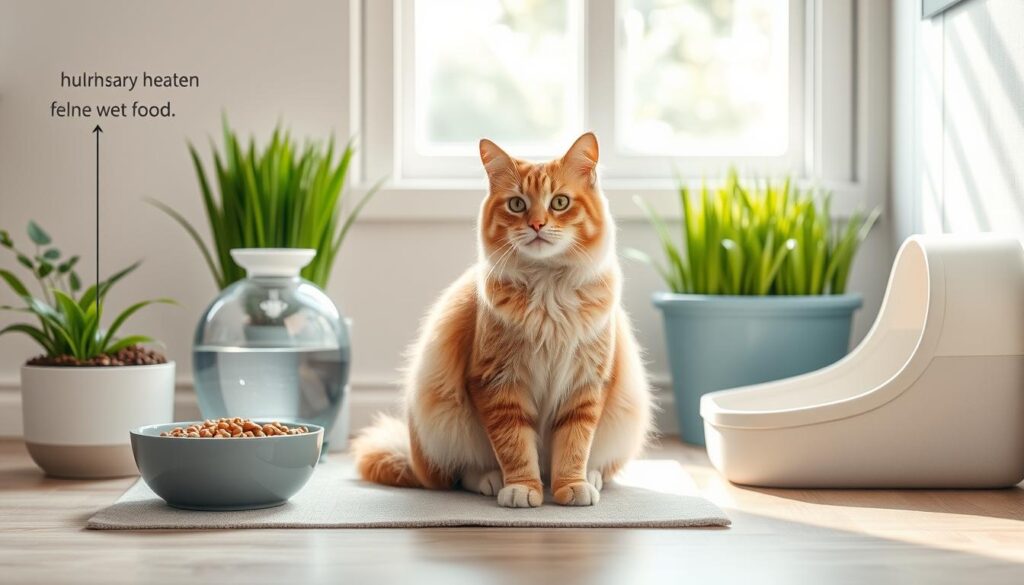
Understanding Stress and Cat Health
Stress is a big factor in feline urinary issues. Cats are sensitive, and stress can harm their urinary health. Environmental changes, new pets, or household disruptions can cause stress-related urinary problems.
- Psychological stress weakens a cat’s immune system
- Chronic stress can lead to recurring urinary tract infections
- Changes in routine can precipitate feline urinary issues
“A stressed cat is more susceptible to urinary tract complications” – Veterinary Nutrition Experts
Genetic Predispositions in Cat Urinary Health
Genetics play a big role in a cat’s risk for urinary tract infections. Some cats are more likely to get UTIs because of their genes.
- Certain cat breeds have higher UTI risks
- Inherited anatomical variations can impact urinary tract function
- Familial health history affects urinary system resilience
Cat health and nutrition are closely tied to genetics. While you can’t change your cat’s genes, knowing the risks helps you prevent problems.
Additional Risk Factors
Other things also increase the risk of urinary tract infections in cats:
- Obesity
- Lack of physical activity
- Underlying medical conditions
- Advanced age
Regular vet visits and a holistic care approach can help manage these risks.
Signs That Your Cat May Have a UTI
It can be hard to tell if your cat has a urinary tract infection. Spotting these issues early is key to avoiding bigger problems. Knowing the signs can help keep your cat healthy.
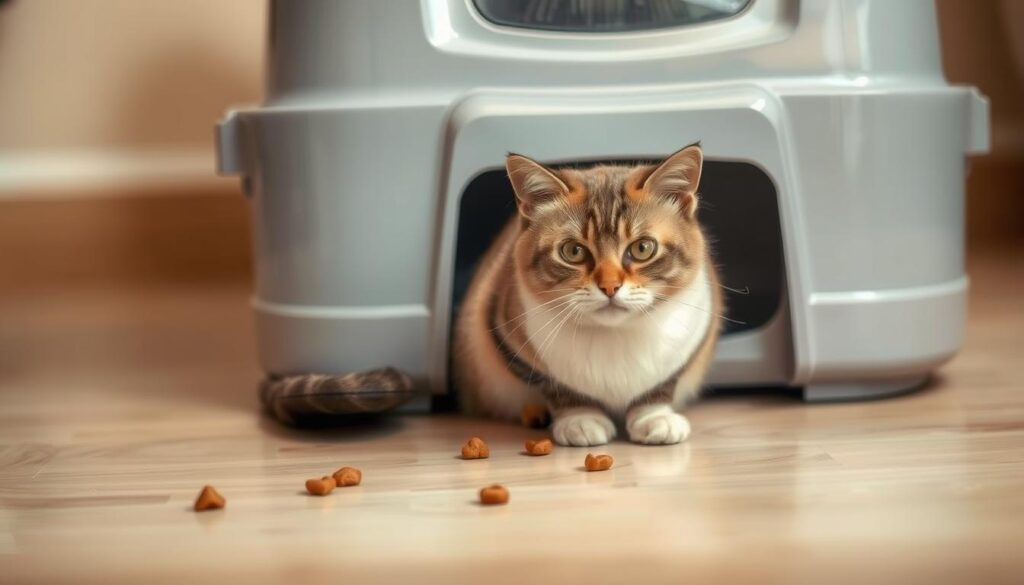
Cats are good at hiding when they’re sick. So, it’s important to watch for signs of a UTI. Your attention could really help your cat’s health.
Behavioral Changes to Watch For
- Frequent trips to the litter box
- Crying or whining while urinating
- Excessive genital area licking
- Hiding or unusual withdrawal from family interactions
- Sudden changes in litter box habits
Physical Symptoms to Monitor
| Symptom Category | Specific Indicators |
|---|---|
| Urination Patterns | Straining to urinate, reduced urine output |
| Visual Signs | Blood in urine, cloudy or strong-smelling urine |
| Physical Condition | Lethargy, decreased appetite, unexplained weight loss |
Pro tip: Female cats are at higher risk of developing urinary tract infections due to their anatomical structure.
“When in doubt, always consult your veterinarian. Early detection can prevent serious health complications.” – Veterinary Urinary Health Expert
If you see several symptoms, get your cat to the vet fast. About 20-30% of cats will face a urinary issue in their life. Being aware and acting quickly is vital for their urinary health.
Veterinary Insights on Cat Nutrition
Understanding cat health and nutrition is key. Veterinarians help guide pet owners to the best diet for cats. This is especially important for preventing feline UTI.
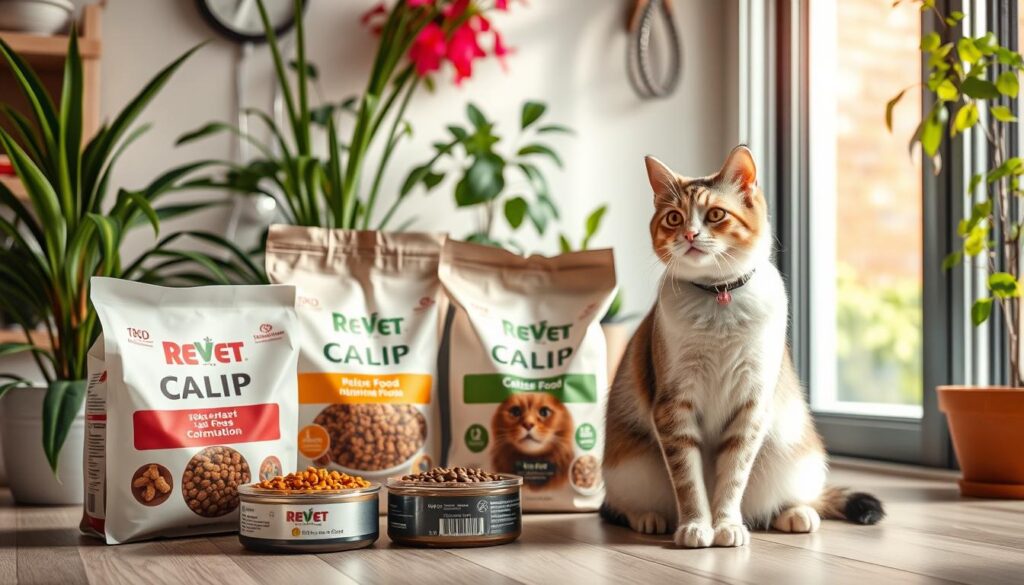
Experts say several strategies can help keep your cat’s urinary tract healthy:
- Choose diets with controlled mineral levels
- Prioritize wet food options
- Monitor protein and moisture content
- Consult with veterinary nutritionists
Expert Perspectives on Kibble and Urinary Health
Vets stress the diet’s impact on cat health. They recommend these brands:
| Brand | Key Nutritional Feature | UTI Prevention Potential |
|---|---|---|
| Hill’s Prescription Diet | Single protein source | High |
| Royal Canin | Hydrolyzed protein formula | Moderate |
| Purina Pro Plan Veterinary Diets | Urinary health support | High |
Recommended Diets for Prevention
Vets suggest a balanced diet for cats. Wet foods provide better hydration, which is vital for urinary health. Brands like Blue Buffalo and Natural Balance offer diets that support overall wellness.
“The right nutrition can be your cat’s first line of defense against urinary tract issues.” – Veterinary Nutrition Expert
Remember, every cat is different. Always talk to your vet to find the best diet for your cat.
How to Choose the Right Cat Food
Choosing the right cat food is important. It affects your cat’s health and can prevent urinary tract problems. Think about what your cat needs and what might harm them.
- Moisture content
- Protein quality
- Mineral levels
- Age-specific nutritional requirements
Critical Factors in Kibble Selection
Research shows certain nutrients are key for urinary health. Good cat food should have the right amount of minerals to avoid crystals.
| Food Type | Moisture | Mineral Levels | Urinary Health Rating |
|---|---|---|---|
| Dry Kibble | 10% | Higher | Moderate |
| Wet Food | 78% | Lower | High |
Comparing Kibble and Canned Food
Canned foods are better for hydration, which is good for the urinary tract. Wet food for cats has about 78% moisture. This is much more than kibble’s 10%, which lowers the risk of urinary problems.
“Hydration is key to preventing urinary complications in cats.” – Veterinary Nutrition Expert
When deciding between kibble and wet food, think about your cat’s health needs. Consider their age and risk of urinary infections.
Prevention Strategies for Cat UTIs
Keeping your cat’s urinary health in check is key. It’s not just about treating UTIs. It’s about creating a plan that keeps your cat healthy and happy.
Knowing about cat health and nutrition is vital. About 27% of cats will get a UTI at some point. So, stopping it before it starts is crucial.
Importance of Regular Veterinary Checkups
Going to the vet regularly is a must. Your vet can:
- Do a full urinalysis
- Look for risk factors
- Give you a plan to prevent problems
Hydration and Diet Tips
Drinking enough water is key for your cat’s urinary health. Cats need about four ounces of water for every five pounds of body weight.
| Hydration Strategy | Effectiveness |
|---|---|
| Water Fountains | 90% cats prefer running water |
| Wet Food Diet | 50% increased moisture intake |
| Flavored Water | 75% improved water consumption |
“Prevention is always better than cure when it comes to your cat’s urinary health.” – Veterinary Nutrition Expert
By using these tips, you can lower your cat’s chance of getting UTIs. This helps keep them healthy for a long time.
Treatment Options for Cats with UTIs
Dealing with urinary tract infections in cats needs a full approach. This includes both medical and nutritional care. When your cat gets a UTI, your vet will suggest a treatment plan just for them.
Common Medications and Therapies
The main treatments for cat urinary health are:
- Antibiotics to fight bacterial infections
- Pain management drugs
- Anti-inflammatory medicines
- Urinary tract supplements
Dietary Adjustments During Treatment
Nutrition is key in managing UTIs. The best diet for cats with UTIs includes:
- Prescription urinary health diets to dissolve bladder stones
- Foods with controlled mineral levels
- High-moisture meals to keep them hydrated
“Proper nutrition can be a game-changer in managing and preventing urinary tract infections in cats.” – Veterinary Nutrition Specialist
Studies show that special diets can dissolve struvite stones in 4 weeks. Important nutritional points include:
| Nutritional Component | Recommended Levels |
|---|---|
| Phosphorus | 0.5-0.9% |
| Magnesium | 0.04-0.9% |
It’s vital to watch your cat’s progress closely. Your vet might ask for follow-up visits to check if the UTI is gone. Remember, every cat is different, so treatments should match their health needs.
Reviewing Popular Cat Kibble Brands
Finding the best diet for cats is key to their health and nutrition. Different kibble brands tackle dry food risks and urinary wellness in unique ways.
Pet owners looking for top-quality cat food have many great options. These brands stand out for their focus on nutrition and health.
Nutritional Profiles of Leading Brands
- Hill’s Science Diet: Specifically formulated for urinary tract health
- Purina Pro Plan: Focuses on targeted nutritional support
- Nutro Wholesome Essentials: Non-GMO ingredient commitment
| Brand | Protein Content | Urinary Health Focus | Price Range |
|---|---|---|---|
| Hill’s Science Diet | High | Optimized Magnesium Levels | $$ |
| Purina Pro Plan | Moderate-High | pH Balance Support | $ |
| Nutro Wholesome Essentials | High | Antioxidant Rich | $$$ |
Expert and Customer Recommendations
Vets stress the need for moisture and balanced nutrition. Freshpet offers high-protein, US farm-sourced options that are refrigerated.
“Choosing the right cat food can significantly impact your pet’s urinary health and overall wellness.” – Veterinary Nutrition Expert
When picking kibble, think about your cat’s needs, age, and health. Regular vet visits can guide you in choosing the best diet for your cat.
The Future of Cat Nutrition
Veterinary science is changing cat nutrition fast. Your cat’s diet is getting more advanced. This is to help them stay healthy and happy.
Now, cat food is moving towards more specific and personal options. Makers are creating foods that tackle health issues like urinary problems.
Emerging Trends in Cat Food Formulation
- Novel protein sources improving best diet for cats
- Limited ingredient diets reducing allergen exposure
- Functional ingredients targeting specific health needs
- Increased focus on wet food for cats with higher moisture content
Innovations in Nutritional Approaches
The future of cat nutrition is exciting. Scientists are working on new ways to improve cat health through food. These include:
- Genetic-based personalized nutrition
- Precision formulations for urinary tract health
- Advanced nutrient combinations
| Nutrition Innovation | Key Benefits | Target Health Concern |
|---|---|---|
| High-Moisture Wet Foods | Improved Hydration | Urinary Tract Health |
| Low Ash Formulations | Balanced Urinary pH | UTI Prevention |
| Targeted Protein Blends | Optimal Nutrient Absorption | Overall Wellness |
Veterinary nutritionists predict a future where cat food is not just fuel, but a comprehensive health solution tailored to individual feline needs.
“Nutrition is the foundation of feline health, and we’re just scratching the surface of what’s possible.” – Dr. Sarah Martinez, Veterinary Nutritionist
Conclusion: Making Informed Decisions
Understanding cat health and nutrition is key, especially about kibble and urinary tract infections (UTIs). Your cat’s diet is important, but it’s not the only thing that matters for their urinary health.
When thinking about if kibble causes UTIs in cats, remember many things affect their health. Vets suggest a whole approach that includes good food, enough water, managing stress, and regular vet visits. Finding the right food for your cat means doing your homework and getting advice from experts.
It’s crucial to know what your cat needs to eat. While kibble can affect their urinary health, working with your vet is essential. Together, you can create a diet plan that keeps your cat healthy and happy.
Balancing Nutrition and Health
Every cat is different, so their diet needs to be too. Watch your pet’s health closely and look out for signs of urinary problems. Being proactive helps you make the best choices for your cat’s health over time.
Final Thoughts on Kibble and UTI Risks
Your commitment to your cat’s health and nutrition is vital. Talk to vets, keep learning, and focus on your cat’s special dietary needs. This way, you can lower the risk of urinary tract infections.

